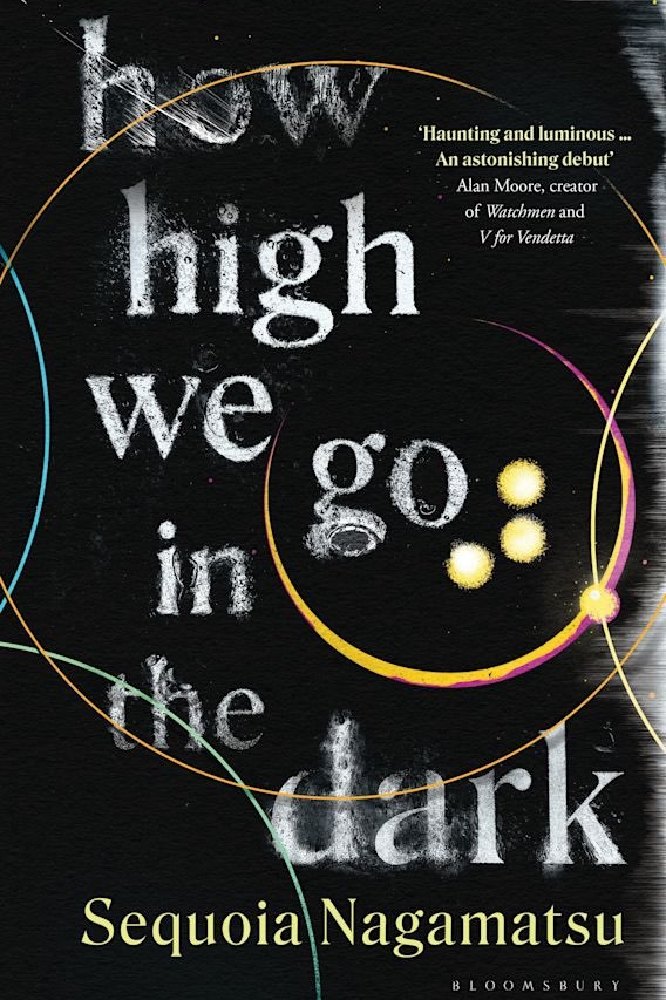It has to be said, when I first read the blurb of this book, I was excited to get stuck in. In hindsight, how could I not have? There were so many themes that I was bound to find something that grabbed me.

How High We Go in the Dark by Sequoia Nzagamatsu / Image credit: Bloomsbury Publishing
“That sounds like a lot of stuff going on”, I was told. I shrugged and muttered something about the different elements probably coming together cohesively. I know now I should never make assumptions about books.
How High We Go in the Dark by Sequoia Nagamatsu is certainly one of the most timely books I’ve read in the past two years, exploring a viral pandemic and the attitudes that arise with it (combined with the attitudes we might have should COVID-19 have killed 50 million as opposed to 5 million.
Other themes explore the imminent dangers of climate change (in a not too distant future), the colonising of other planets, stem cell research and the use of VR technology. All things that our world faces beyond sci-fi.
Each chapter is written from the perspective of a different character in a different time period, with a different science fiction “theme”. So the tales of each are only ever revisited through often casual links with other characters. It also takes place over a series of, well, technically, thousands of years.
Details about the characters are so interesting and memorable that it’s not all that difficult to keep track of the names; this is a remarkable talent, and one that is absolutely necessary for a book like this. There were very few times I had to flick back through the book to work out why a name sounded so familiar.
Now, I’m not in a position to judge the accuracy of some of the science in this book (not being an expert in any scientific field myself), but it certainly appears to be written by someone with a comfortable amount of knowledge regarding biology, epidemiology, astrophysics and forensic science among others. But with no scientific degrees himself, Sequoia Nagamatsu has relied on a heavy amount of research to an extent that you can’t fault his passion, as well as his respect for his readership. I love to read books when it’s clear that the author has put blood, sweat and tears into trying to make it as believable as possible.
In spite of all the science jargon, I never felt overwhelmed by it and it never appeared overly clinical; it’s a beautifully written novel that is mostly easy to follow.
From a creative writing standpoint, it’s extremely emotional to get through. It’s bleak and morbid, but with glimmers of hope throughout. It’s a novel of deep romance, loyal friendships and complicated family drama disguised as sci-fi. And through it all, this exploration of the nature of life and death feels extremely important.
Imagine living in a world where death is a part of everyday life for everyone. Death isn’t a taboo subject anymore, and people are determined to take control of their own demises. Of course it’s going to be a bit creepy, and often shocking. A euthanisia theme park for terminally ill kids? Elegy hotels for families to spend the night with their deceased loved ones? It’s all very disturbing, and is a great example of how capitalism will jump on even the most vulnerable, but it also reflects the importance of people’s needs when it comes to experiencing death.
Occasionally, it enters far-fetched territory which frankly takes away from the reality of a global pandemic, e.g. comas in which people wake up in a kind of purgatorial void with a zero gravity “ceiling”, while communicating with other sick people and viewing their memories… The “wtf” effect of that chapter lasted until the end of the book. And speaking of the end of the book, we meet some kind of Mother Earth type goddess-turned-mortal, reincarnated into some of the characters throughout the book - this just felt like a bizarrely rushed way to explain away a necklace that disappeared in the beginning, and a mummified semi-Neanderthal from whence the pandemic originates. A poetically written final chapter, but disappointing in its substance.
There are some unusual anachronisms within the novel, such as multiple references to people carrying around photos, a printing press being used to spread propaganda, and handwritten letters and journals. I was initially going to criticise this (I mean, how many people carry photos now when you can just have photos on your phone? Who writes when they could type?), but the more I thought about it, the more I realised that it was a metaphor for life; how the tangible will always be what makes us human, no matter how much technology changes and dies out.
If you’re after a great plot and cohesive storyline, this isn’t the book for you. The book reads more like a series of short stories, and indeed if you look at Nagamatsu’s bibliography, you’ll see that several of the chapters - The Songs of Your Decay, Elegy Hotel and Grave Friends - have previously been published as short stories. I have to say this was a disappointing discovery. There’s a certain laziness about throwing together a bunch of previously executed ideas and calling it a novel, and it makes total sense why this book never seems to “flow”.
MORE: Best books of January 2022
If it were a series of short stories, this review would have a higher score (not a 5-star rating, as they don’t always have endings, as it were). Ultimately, there are a lot of ideas here, and not all of them have been fully realised in How High We Go in the Dark. But it is, regardless, an important study into human temperament behaviour, and that, at least, never feels inauthentic.
Key quote: “How do you sing a lullaby in Neanderthal?”
Tagged in Sci Fi Books Book releases

